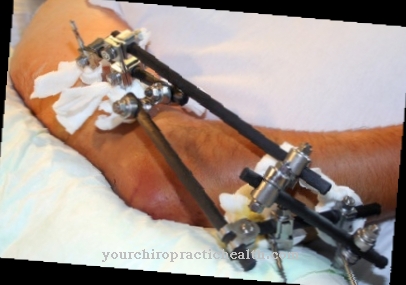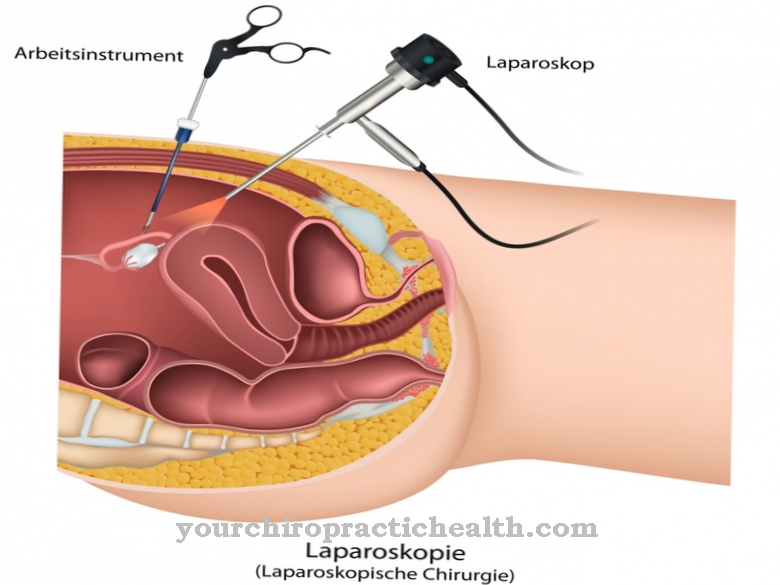The Ductoscopy is a modern examination method in which the milk ducts in the breast of women can be mirrored from the inside. The main indication for this form of diagnosis is the secretion of unclear, especially reddish, fluids from the nipple. By assessing the respective milk duct, it is possible to detect even small changes with the help of ductoscopy and thus to detect both benign nodules and malignant neoplasms at an early stage.
What is ductoscopy?

Ductoscopy is also called Endoscopy of the milk duct or Galactoscopy designated. It is one of the endoscopic examination methods, as the diagnosis is based on images that are taken from inside the body with the help of a very thin endoscope, in this case directly from the milk ducts of the female breast.
Thanks to the possibility of using a tiny camera to provide meaningful images of the milk duct system, ductoscopy as a minimally invasive diagnostic method can in many cases replace the open biopsy associated with general anesthesia. The doctor can follow the images from the milk duct on the monitor at the same time.
On the one hand, this gives you the opportunity to take a closer look at any suspicious areas, and on the other hand, the constant visual inspection effectively minimizes the risk of complications or injuries. Important: Galactoscopy, as a reflection of the milk ducts, must not be confused with galactography, in which the female milk ducts are shown in the X-ray image using contrast media in addition to mammography.
Function, effect & goals
The main area of application for ductoscopy is the leakage of a bloody secretion from the female nipple, for which there is no conclusive explanation. This can be done from both breasts or from one side. Some secretions occur spontaneously, others are only triggered by pressure.
Important for the indication for a milk ductoscopy is the lack of an obvious cause, which - often especially in the case of clear or milky liquids - can be determined for example hormonally (for example during pregnancy) or through the use of certain medications. The minimally invasive procedure is usually only used when the classic imaging procedures such as sonography or mammography have either not shown anything or have an initial image finding that needs further clarification.
A nipple swab to detect possible pathogens is also often carried out in advance. At the beginning of every galactoscopy there is a gentle anesthetic, which can also be done as a local anesthetic during this examination. With the help of pressure, an attempt is made to provoke the leakage of the liquid in order to better detect the affected milk duct. The very fine endoscope with its camera is now inserted into this.
For a better view, the examiner slightly expands the milk duct and rinses it with a physiological and therefore well-tolerated saline solution. This means that even the smallest lesions in the milk duct can be easily recognized and the doctor can use the screen control to navigate through the branched system of the milk ducts to where the triggering cause is. If the findings are visually unclear, a smear or a puncture can be made in the same work step in order to subsequently examine the material obtained pathologically.
If it turns out during the examination that the patient needs an operation based on the findings, the affected milk duct can be marked immediately during the galactiscopy. This is usually done with a small wire that is not only easy to find during the surgical procedure, but can also be recognized in other imaging methods and thus marks the diseased area.
A common finding that leads to the use of ductoscopy is the papilloma of the milk ducts. DCIS (ductular carcinoma in situ) is already a precancerous stage and therefore requires treatment, in which pathological cell changes are already evident, but which have not yet invasively spread into the tissue outside the milk ducts. The DCIS can also be detected early with the help of ductoscopy and has a good prognosis if treated promptly.
Risks, side effects & dangers
Ductoscopy is a very low-risk procedure, especially when compared to the surgical alternative - the open biopsy. As with any endoscopic examination, there is also a low risk of damaging tissue and causing bleeding in the area of the milk ducts.
However, this low risk is disproportionate to the benefit that the examination can offer, especially with regard to the early detection of a precancerous stage. The constant visual control of the position of the endoscope via the monitor, the good view due to the flushing with the saline solution and the maneuverability of the semi-flexible device can avoid complications in most cases.
In contrast to mammography and the galactography that is sometimes associated with it, only camera recordings are made with the milk duct mirroring. X-rays are not used. In addition, in comparison to galactography, no contrast agent has to be injected into the milk duct, so that ductoscopy is also suitable for patients who sometimes have an allergic reaction to such agents.
The anesthesia chosen - general anesthesia or local anesthesia - is associated with the general risks that apply to any procedure, which, however, rarely occur and are usually easy to control. Another very gentle variant of mirroring is duct ultrasonography, in which ultrasound images are brought directly from the inside of the milk duct in question to the doctor's monitor and narrow areas that are detected can be examined in more detail.












.jpg)



.jpg)










.jpg)
